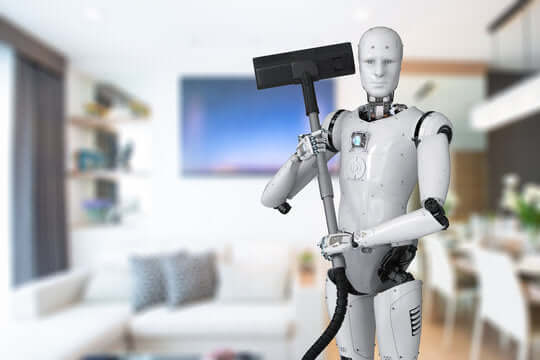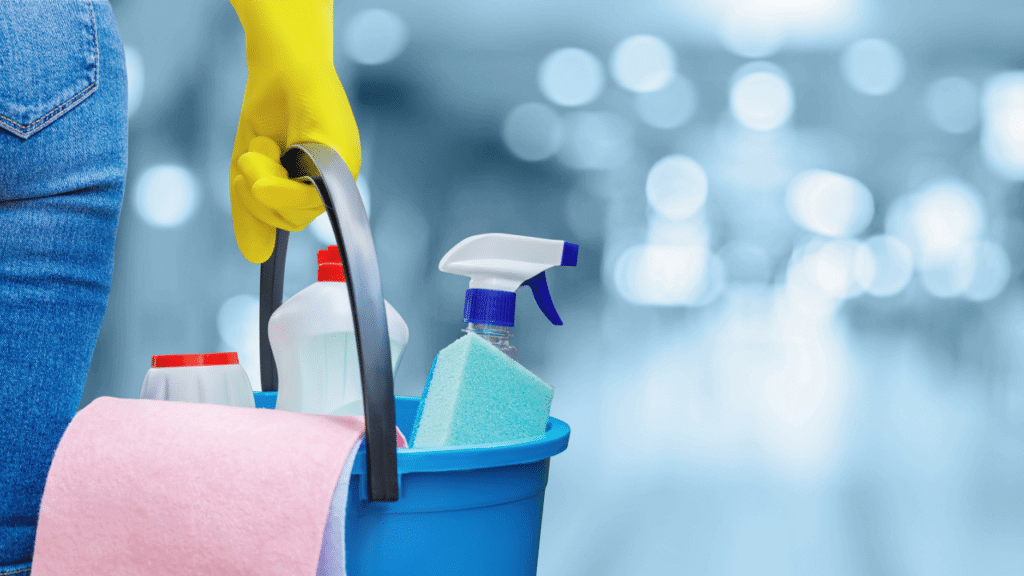Remember when "smart home" meant clapping to turn your lights on and off? (If you're under 30, just nod and pretend you get the reference.) We've come a long way from those prehistoric days of home automation. Today's cleaning technology isn't just about making things easier—it's fundamentally transforming our relationship with household maintenance. As someone who's been covering home tech for over a decade, I can confidently say we're living through the most exciting period of innovation in cleaning technology since the vacuum cleaner first rolled into homes a century ago.
Let's dive into the six most significant trends that are changing how we think about keeping our living spaces clean in 2025. These aren't just incremental improvements—they're paradigm shifts that could make your current cleaning routines as outdated as washing clothes in a river.
1. Predictive Cleaning: From Reactive to Preventative
Traditional cleaning is reactive—you wait until something is visibly dirty, then you clean it. The emerging paradigm flips this model entirely: predictive cleaning systems identify and address messes before they become problems.
What's Happening Now:
Advanced sensor networks throughout the home are monitoring factors like:
- Foot traffic patterns in different areas
- Environmental conditions (humidity, temperature)
- Usage patterns of different spaces and surfaces
- Seasonal factors affecting cleaning needs
These systems then deploy automated cleaning resources preemptively rather than on a fixed schedule or after messes occur.
Real-World Applications:
- Smart floor systems that detect higher traffic areas and direct robotic cleaners to focus attention there
- Bathroom humidity sensors that trigger ventilation to prevent mold growth
- Kitchen surface monitors that detect splatter from cooking and schedule targeted cleaning
- Entry area systems that intensify cleaning during pollen season or after rainy days
Where This Is Headed:
The holy grail is a fully integrated home environmental management system that coordinates multiple cleaning devices based on real-time conditions and predictive algorithms. Your home will essentially clean itself at optimal times based on your family's actual usage patterns rather than arbitrary schedules.
One manufacturer is developing a system that notices when your oak tree starts dropping pollen and automatically increases air filtration while scheduling more frequent floor cleaning—without you having to notice or request it. That's the level of environmental awareness we're approaching.
2. Specialized Surface Science: Material-Specific Cleaning
The one-size-fits-all approach to cleaning is disappearing as technology enables highly specialized approaches for different materials.
What's Happening Now:
Advanced materials identification allows automated systems to recognize surfaces and adjust cleaning methods accordingly:
- Optical recognition identifies wood species, stone types, fabric compositions
- Sensors detect surface porosity and fragility
- AI systems remember the surfaces in your home and customize approaches
Real-World Applications:
- Robotic systems that adjust pressure, moisture, and cleaning agents based on the exact surface they're cleaning
- Multi-chamber cleaning devices carrying different solutions for different materials
- Specialized micro-brushes that deploy only on appropriate surfaces
- Variable steam pressure systems that automatically adjust to surface heat tolerance
Where This Is Headed:
The future brings cleaning systems with material science databases that know exactly how to handle every surface in your home. Your marble countertops will receive different treatment than your engineered quartz, while your hardwood floors get different care than your luxury vinyl tile—all automatically, without you having to program anything.
Manufacturers are even developing cleaning systems that can identify the specific stain or soil type (red wine vs. coffee vs. mud) and deploy the most effective removal approach automatically. The days of Googling "how to remove [X] from [Y]" could soon be behind us.
3. Biological Cleaning Systems: Harnessing Nature's Janitors
While most cleaning innovations focus on hardware and chemistry, the most revolutionary approach may be biological—harnessing microorganisms to do our cleaning for us.
What's Happening Now:
Bio-cleaning uses beneficial microbes to:
- Consume organic waste and odor-causing compounds
- Outcompete harmful bacteria on surfaces
- Break down complex stains enzymatically
- Create self-maintaining microbial ecosystems on surfaces
Real-World Applications:
- Probiotic surface sprays that continue cleaning for days after application
- Bio-active drain treatments that prevent clogs and eliminate odors
- Enzymatic cleaning systems targeted at specific types of organic matter
- Microbial air purification that captures and digests allergens
Where This Is Headed:
The most exciting developments involve creating stable microbial ecosystems on household surfaces. Rather than sterilizing everything (which creates a vacuum that harmful microbes quickly refill), these systems establish beneficial microbe colonies that actively prevent pathogen growth while breaking down dirt and organic matter continuously.
One company is developing bathroom tiles with microscopic reservoirs that harbor beneficial bacteria, which activate when moisture is present. The tiles essentially clean themselves between traditional cleanings by maintaining a healthy microbiome. Another is creating kitchen cutting boards with similar technology to reduce cross-contamination risks.
The paradigm shift here is profound: instead of killing all microbes indiscriminately, we're learning to cultivate the helpful ones as microscopic cleaning allies.
4. Waterless and Low-Moisture Cleaning: Conservation Meets Performance
Water scarcity concerns are driving innovations in cleaning technologies that maintain or improve performance while dramatically reducing water usage.
What's Happening Now:
- Dry cleaning technologies for traditionally water-dependent applications
- Ultrasonic and UV cleaning systems that replace water-based approaches
- Micro-mist technologies that provide deep cleaning with minimal moisture
- Electrostatic systems that attract dirt without water as a carrier
Real-World Applications:
- Waterless dishwashers using UV and ultrasonic technology
- Dry shower systems that clean the body without traditional water usage
- Micro-mist surface cleaners that use 95% less water than spray bottles
- New-generation steam cleaners that extract more cleaning power from minimal water
Where This Is Headed:
As water costs increase and conservation becomes more critical, expect waterless cleaning to become the default rather than a specialty approach. Systems that were once considered high-tech or industrial are being miniaturized and price-optimized for home use.
The most promising technology combines electrostatic attraction with specialized dry polymers that encapsulate dirt and lift it from surfaces without water as a carrier. Early tests show these systems are more effective than traditional wet cleaning for many applications, while using virtually no water.
5. AI-Enhanced Cleaning Robots: Beyond Navigation
We've had robotic vacuums for years, but today's cleaning robots bear the same relationship to their ancestors as smartphones do to rotary dial telephones.
What's Happening Now:
- Multi-surface capability with auto-detecting transitioning
- Hand-like manipulation for moving objects during cleaning
- Object recognition beyond simple obstacle avoidance
- Learning algorithms that improve cleaning strategies over time
Real-World Applications:
- Advanced robotic window cleaners like the SmartPro UltraClean that recognize different window types and adjust cleaning patterns
- Pool robots like the Hydro-Puls that learn your pool's unique shape and trouble spots
- Floor cleaning systems that recognize and appropriately handle different types of messes
- Multi-purpose robots that can vacuum, mop, dust, and even handle basic tidying
Where This Is Headed:
The next generation of cleaning robots will do more than clean around your possessions—they'll interact with them intelligently. Imagine a robot that can:
- Move lightweight furniture to clean underneath, then return it precisely
- Pick up toys and clutter, sorting them into appropriate containers
- Detect when a plant has been knocked over and clean up the soil
- Distinguish between trash and valuable items when deciding what to discard
These capabilities are already appearing in commercial prototypes and will reach consumer markets within the next 2-3 years. The limitations of current robots—their inability to handle stairs, manage clutter, or clean complex objects—are being systematically eliminated.
6. Augmented Reality Cleaning Assistance: Seeing the Invisible
AR technology is revolutionizing how we perceive and address cleanliness by making the invisible visible.
What's Happening Now:
AR systems help users:
- Visualize microscopic contaminants and bacteria
- See residual cleaning product that needs rinsing
- Identify areas commonly missed during cleaning
- Receive real-time guidance on techniques and product usage
Real-World Applications:
- AR cleaning glasses that highlight areas needing attention
- Smartphone apps that use the camera to detect invisible soils
- Projection systems that display cleaning guidance directly onto surfaces
- Training systems that teach proper technique through visual overlays
Where This Is Headed:
The most promising development combines AR visualization with automated systems. For example, a bathroom cleaning system that:
- Scans the entire bathroom and highlights all areas needing attention
- Suggests the appropriate cleaning approach for each surface
- Tracks your cleaning in real-time, marking areas as "complete"
- Verifies effectiveness through post-cleaning scanning
- Maintains a cleanliness history for your space
For professionals, these systems dramatically improve training and quality control. For homeowners, they transform cleaning from guesswork to precision, ensuring you never miss spots and don't waste time over-cleaning already sanitized areas.
What This Means For Your Home
These innovations aren't just about doing the same old cleaning with fancier gadgets—they're about fundamentally rethinking what "clean" means and how we achieve it. As these technologies mature and combine, we're moving toward a future where:
- Cleaning becomes primarily preventative rather than reactive
- Multiple specialized systems work in coordination rather than isolation
- Human involvement shifts toward oversight rather than execution
- Resource usage (water, energy, chemicals) decreases while effectiveness increases
- Health considerations become central to cleaning, beyond mere appearance
The home of 2030 will likely have an integrated cleaning ecosystem that manages itself with minimal human intervention—combining surface science, biological approaches, AI robotics, and predictive algorithms to maintain optimal conditions continuously rather than periodically.
The Human Element: What Won't Change
Despite all this impressive technology, some aspects of cleaning will remain refreshingly human:
- Personal preferences still matter: What "clean" means varies from person to person, and AI systems will need to learn your particular standards.
- Emotional satisfaction is real: Many people get genuine satisfaction from certain cleaning activities, and technology should complement rather than replace these meaningful tasks.
- Judgment calls require humans: Deciding whether to toss or keep an item, how to handle delicate heirlooms, or when to make exceptions to rules remains firmly in human territory.
- The human touch remains irreplaceable for certain tasks: The care we take with cherished possessions communicates something technology can't replicate.
The most successful cleaning innovations will be those that handle the tedious, repetitive aspects of cleaning while leaving the meaningful, judgment-requiring elements to humans. The goal isn't to remove people from the equation but to elevate their role from manual laborer to environmental manager.
The Bottom Line: Should You Invest Now or Wait?
With technology evolving so rapidly, the eternal question is whether to invest now or wait for something better. Here's my practical advice:
- Robotic floor cleaners are mature enough to invest in now. The return on investment in time saved is substantial.
- Specialized robots for windows and pools like the SmartPro UltraClean and Hydro-Puls make sense if you have significant needs in these areas.
- Biological cleaning products offer meaningful benefits today with minimal investment required to try them.
- Major integrated systems might warrant waiting another 12-24 months as standards develop and interoperability improves.




Leave a comment
This site is protected by hCaptcha and the hCaptcha Privacy Policy and Terms of Service apply.